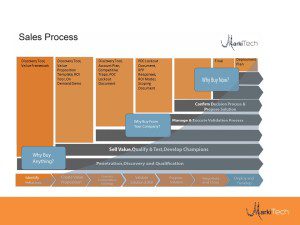
In simple words, because, without a bit – no, a lot – of help, it’s not supposed to. There’s something seriously wrong with your penetration, commercialization and marketing strategy if you believe your product is so unique that potential clients will be queueing up to buy them before you run out of stock. Now, don’t get me wrong, please! Of course your product is unique; every daddy thinks his kid is Carl Sagan. The problems start when you try to convince others too that he’s Carl Sagan! I’m sure you’ve met your fair share of really very brilliant fresh-faced computer whizzes who’ve written the latest brilliant “program to beat all programs” – it could be in personal gaming, enterprise security, corporate accounting, or online medical diagnosis, anything really; it’s irrelevant – and have earned a lot of praise in the trade journals. But are still completely flummoxed by their next to non-existent sales.
It doesn’t once cross their mind that while they’ve invested months in the product development and coding, they really haven’t given the same kind of thought to the sales and marketing process. Why should their target customer buy a new software solution or service? Why should they buy it from you, and not your competitor? And why should they invest in the new purchase now, and not – say – a year down the road? The constant refrain is: “how can they (the clients) not see that our service is what they need, and now”? The answer to this one is simple: you’re not showing them!
Okay! Enough of the dancing in the dark; out with paper and pencil (but you’re allowed to play Springsteen if you like). The thing here is that, like any other service, SaaS is a service you’re trying to sell. And if you haven’t guessed it by now, there are just three broad sequential levels you need to develop to get a sale in the bag. These three songs should take you there.
- “You know you want me, baby”- Identify and/or create need?
By and large, your large scale enterprise level client has been in its business for a reasonable amount of time and has well-conceived and well-articulated business strategies that have been translated into initiatives. And these strategic business initiatives, rather than anything else, inform the IT investment decision. Your challenge, as the maker of that SaaS product, is to understand these initiatives before you can start talking about your value proposition. In brief, know yourself what they need before you start telling them what they need. And of course, the unavoidable corollary, create need where there isn’t one. Not in a malicious Don Draper sort of way, but by identifying gaps in their overall IT capability that are holding them back from exploiting higher levels of profitability. If anything does, that’ll get them salivating. But that demands a much deeper level of understanding and interaction with your client than your cookie cutter sales and marketing strategies are geared up for. Don’t be an undifferentiated commodity; become your client’s partner, by advising at all management levels on why they need your solution. Show the big profitability picture to the executive level, because they make the strategies; to the middle managers, show how your solution will enable them to translate these broad strategic goals into achievable initiatives; and to all the “SEAL teams” working in the company, show them the improvement in their critical operational capabilities your solution has to offer.
- “You’re the Only One Value Proposition” – Why your solution is the best in the market?
The race has begun, and you and your competitor startup firm are off to a start. But oddly, your most challenging adversary may not be the other startups, not even the perpetually licensed on-premise packages and internally developed solutions; it’s indolence. There are simply so many processes running simultaneously that migration to a new solution can be perceived as severely disruptive. So, while there are other startup competitors, your sales strategy will need to address the challenges presented by the incumbent solutions as well. You will therefore need to be completely on top of the success criteria for each of the three management/operation levels described above i.e., executives, middle managers, and functional operators. The success metrics for each are different, and since you (who else?) are the one who knows his SaaS product and Saas product marketing the best, the onus is upon you to help the three levels establish their business, architecture and functionality benchmarks. Refine your message and metrics to address the concerns of each of these levels in terminology that will resonate with them, so you have a buy-in at each level. While the check will necessarily be signed by the executive cadre, unhappy middle managers and functional managers will not be able to deliver the productivity you have promised to the executive level. So, talk to the three levels, in depth, and write your message separately for each of them. Firstly, you need to get them to sit up and take notice of the need (addressing the indolence bit here) and secondly you have to have each level actually look forward to migrating to your software service, in preference over new competition.
- “No better time than NOW – Hype factor” – Why your client should invest in your SaaS now and not later?
Okay! The battle’s been fought and won, and the battlefield is littered with the corpses of the incumbent royalty (the legacy solutions) and the young pretenders (the new competitor startups – infact 90% of all tech products fail and even those funded by 70% chances of fail); you need to return to the value proposition to convince your client why your SaaS service should be enthroned. In short, “where’s the beef”. You are now on-stage using techniques like digital marketing and are ready to make your big Al Pacino speech. And the client wants to know how much more it can make by spending on you than by spending on something else or not spending at all. Read my lips – or in this case – my words. Return. On. Investment. Your SaaS has to mean something in terms of profitability for it for be a “sell”. Your company’s capabilities and operational benefits should be translatable into achievement of the strategic initiative. Your big presentation should be able to shine a (polite) critical light into the operational inefficiencies and challenges of the existing environment, and a bespoke prescription for all the illnesses diagnosed in the process, organized to deliver value by focusing on the most critical functions first and working its way down towards the least.
SaaS product marketing is an entirely different way of marketing, one we haven’t seen before. If your client is happy, he’ll be interested to invest in your entire suite; if not, he won’t mix and match you with other suppliers. And more than any advertising, the good recommendation of a satisfied client will be the deciding factor in how your SaaS product flies off the shelf.
If you like the article and want to learn more on how we can help – we encourage you to attend or share with your friends, colleagues our latest webinar on one of the several ways to help bring your product to limelight using digital marketing.
Written by Khurram Jamil Butt
Edited by Nauman Jaffar
MarkiTech


Recent Comments